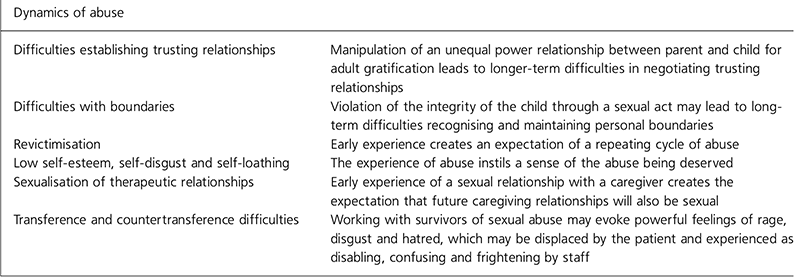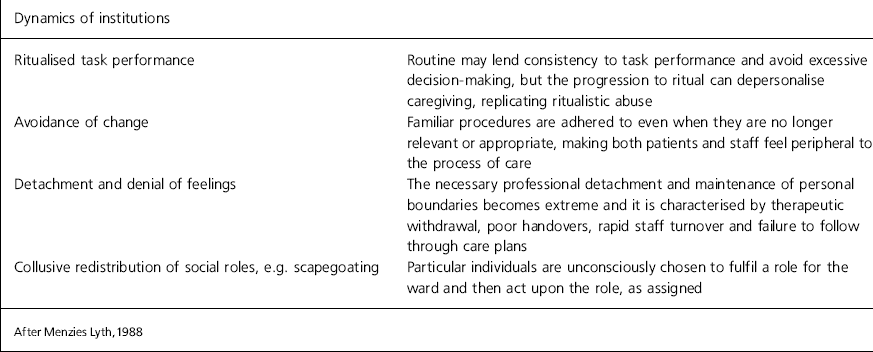This paper describes rehabilitation principles and some specialised practice that could usefully inform the provision of acute in-patient care. A low secure rehabilitation setting is described using a method of case formulation to embed an envelope of care around an individual patient within a therapeutic ward milieu. This increases the collaboration and transparency around individual care planning and the capacity for self-reflection within the multi-disciplinary team, in a manner that may be applicable to other in-patient settings.
The dynamics of in-patient settings
These are related to the dynamics of institutions, of psychosis and of abuse (Reference Davenport, Mace and MargisonDavenport, 1997).
There is a high prevalence of childhood sexual and physical abuse among psychiatric in-patients (Reference Wurr and PartridgeWurr & Partridge, 1996), with some responses being conditioned by previous abuse. Typical dynamics of abuse include splitting, revictimisation, difficulties within power relationships and sexualisation of relationships in general.
Patients receive care within an institution that operates social defences to reduce the anxiety, guilt, uncertainty and doubt of those that work in the ward (Reference Menzies LythMenzies Lyth, 1988), but the impact of these factors is still felt by the patients. Psychic defence mechanisms that protect against the full experience of anxiety become incorporated into the socially structured defence system of the hospital (the modus operandi of that particular institution). These psychic defences are generally unconscious and primitive and include splitting, scapegoating, ritualisation and detachment.
Most patients on an in-patient ward will have psychosis; some of their interpersonal behaviour will be driven by the psychological mechanisms underlying psychotic states. These include projection and projective identification, being suspicious and feeling persecuted, and grandiose omnipotence.
Primitive unconscious defence mechanisms that can amplify each other are common to all three sets of dynamics, leading to an anti-therapeutic environment, characterised by scapegoating, fragmentation, omnipotent (and unhelpful) power relationships and malignant alienation. Communication is often primitive, may preclude thought and may replicate the adverse dynamics of early childhood (or current family difficulties).
Power relationships between patients living together in intimate and anxiety-provoking circumstances have the potential to become sexualised and to affect staff. Relationships become subverted within a victim/perpetrator dyad. Some patients become powerless, while others are seen as predatory. Women patients are most often adversely affected.
Staff find it particularly challenging to handle these difficulties with sensitivity; they can contribute to poor outcome, characterised by treatment drop-outs, lack of meaningful therapeutic relationships and acting-out behaviour. For staff, the outcome is equally poor, with lack of job satisfaction, a high staff turnover and high sickness rates.
Typical components of these three sets of dynamics are given in Tables 1,2,3.
Table 1. Dynamics of abuse

| Dynamics of abuse | |
|---|---|
| Difficulties establishing trusting relationships | Manipulation of an unequal power relationship between parent and child for adult gratification leads to longer-term difficulties in negotiating trusting relationships |
| Difficulties with boundaries | Violation of the integrity of the child through a sexual act may lead to long-term difficulties recognising and maintaining personal boundaries |
| Revictimisation | Early experience creates an expectation of a repeating cycle of abuse |
| Low self-esteem, self-disgust and self-loathing | The experience of abuse instils a sense of the abuse being deserved |
| Sexualisation of therapeutic relationships | Early experience of a sexual relationship with a caregiver creates the expectation that future caregiving relationships will also be sexual |
| Transference and countertransference difficulties | Working with survivors of sexual abuse may evoke powerful feelings of rage, disgust and hatred, which may be displaced by the patient and experienced as disabling, confusing and frightening by staff |
Table 2. Dynamics of institutions

| Dynamics of institutions | |
|---|---|
| Ritualised task performance | Routine may lend consistency to task performance and avoid excessive decision-making, but the progression to ritual can depersonalise caregiving, replicating ritualistic abuse |
| Avoidance of change | Familiar procedures are adhered to even when they are no longer relevant or appropriate, making both patients and staff feel peripheral to the process of care |
| Detachment and denial of feelings | The necessary professional detachment and maintenance of personal boundaries becomes extreme and it is characterised by therapeutic withdrawal, poor handovers, rapid staff turnover and failure to follow through care plans |
| Collusive redistribution of social roles, e.g. scapegoating | Particular individuals are unconsciously chosen to fulfil a role for the ward and then act upon the role, as assigned |
Table 3. Dynamics of psychosis

| Dynamics of psychosis | |
|---|---|
| Splitting | Staff and patient groups are artificially split into good v. bad or victim v. perpetrator |
| Grandiose omnipotence | Patients (or staff) feel entitled to act as if they are all-powerful |
| Pathological projective identification | Parts of the self are experienced as intolerable and are projected out into others; they unconsciously respond in accordance with the projection. As patients often project intolerable aggression or rage, staff may be perceived as dangerous |
| Persecutory states | Potentially good figures are regarded with intense suspicion |
| Inhibition of symbolisation (failure of verbal linking) | The use of pathological projective identification may disrupt thinking and lead to disordered interpersonal behaviour |
These dynamics are linked to psychological processes in early development and have the potential to amplify each other. They require a sufficiently reflective ward culture to contain primitive aggression and hostility, ensure safe physical and psychological boundaries and enable reflection on, rather than enactment of, interpersonal processes. The opportunity for the residents of a ward to meet together with staff to discuss and reflect on interpersonal difficulties as they arise is crucial.
Development of a therapeutic milieu at the Bowness Unit, Salford
The purpose of this unit is to promote recovery, safety and quality of life, while delivering the most effective treatment options. It draws on an integrated model, similar to the Need-adapted Finnish model (Reference Alanen, Lehtinen and RakkolainenAlanen et al, 1991) summarised below:
-
• therapeutic treatments are planned individually to meet the needs of patients and of the people nearest to them
-
• the treatments are characterised by the psychotherapeutic attitude, with efforts to try to understand what has happened and happens to the patients and those nearest them
-
• different therapeutic activities must support, not counteract, one another
-
• the treatment is a developmental and interactive process.
The approach assumes that schizophrenia is a neurodevelopmental disorder, where the course of illness is profoundly influenced by the patient's early experience (particularly of deprivation or abuse), by low self-esteem and by the ward environment.
The ward must act as a safe ‘container’ for patients and staff. The environment conforms to the recommendations of Safety First (Department of Health, 2001a ). All staff are trained in the management of violence and in breakaway techniques. Nurses are trained in care and responsibility methods — the safe restraint of a violent patient using a three-person team. The ward is locked, so that its physical boundaries are clear, and the routine is structured and predictable.
Written information about the ward routine, activities and treatment options are given to each patient. Patients and family are also given a verbal induction to the ward.
The ward has separate sleeping, toilet and bathroom facilities for men and for women, with separate sitting and smoking rooms for each gender. Social mixing between men and women can occur in the dining areas, activity and rehabilitation facilities, according to individual need. There is a considerable staff contribution to the support and supervision of mixed gender areas in order to reduce the development of unequal or exploitative relationships.
All staff have basic training in psychosocial interventions and many of the qualified staff are trained in cognitive—behavioural therapy, family work or in working with substance misuse. There is a strong emphasis on good, transparent, multi-disciplinary working, with team supervision available.
Therapeutic community principles are applied through a weekly ward community group, a weekly ‘democratic’ multi-disciplinary team meeting and extensive twice-daily staff handover meetings to ensure accurate exchange of information. All qualified and most unqualified care staff have clinical supervision and access to additional staff support for work-related issues. However, the provision of a weekly facilitated staff support group has not been popular among the staff group and is presently not operating.
A range of activities is provided on the ward, including a women's and a men's group, art therapy sessions, training in independent living skills, psychological interventions and anxiety management. Activities are also provided in an off-ward activity centre, which houses a gym, games room, rehabilitation kitchen and social centre for family and child meetings. Educational activities linked to local colleges are also available. There is a user-led social centre and effective collaboration with a local employment service.
Using case formulation
Case formulation has been developed as a method of creating a shared psychological understanding around a patient and locating that within the complex ward dynamics. Each patient has an internal care coordinator and team of co-workers, including a social worker, occupational therapist and trainee psychiatrist. They meet regularly with the psychologist or responsible medical officer (RMO) over the first weeks of admission, with the aim of developing a formulation of the patient's strengths and target problems.
The formulation is based on an in-depth discussion of the patient's history, risks and family relationships. Each team member speaks to the patient about his or her concerns and the patient's own goals for treatment. Some team members also meet the family. Each interaction contributes to the formulation, helping to identify the patient's core self schemas and beliefs, positive coping strategies, dysfunctional attitudes and behaviours in the ward setting, and the likely staff responses. These countertransference responses are discussed explicitly and lead on to the specification of appropriate therapeutic attitudes. The desired therapeutic responses are then built into the formulation, so that both patient and care team have this ‘map’ or ‘script’ to negotiate the inpatient process. Care plans are then developed to reflect the way of working identified within the individual case formulation.
The case formulation may be used to manage the timing of a complex series of interventions to ensure that different treatments are complementary rather than competing. It may also be used to focus on strengths and difficulties in clinical supervision and in team supervision when splitting becomes an issue.
The formulation is shared with the patient and his/her family at an appropriate time.
Conclusion
The provision of a therapeutic environment on an inpatient ward is one of the great challenges for general psychiatry today; the dynamic complexity of a modern ward setting is often experienced as overwhelming or alienating by both patients and staff and leads to sub-optimal outcome. Understanding the prevalent dynamics that cluster around patients who are ill and the need to detoxify them may improve outcome. The individualised therapeutic envelope, or case formulation, embedded within the ward setting can provide a ‘map’ to help both patients and staff negotiate the complex process of in-patient care.
Although the description relates to a longer-term setting, the important ingredients such as staff training and clinical supervision, taking a shared view of the case formulation, and operating within a self-reflexive environment where the rules are unambiguous, are all transferable to an acute ward setting. The shorter length of stay clearly demands an early focus on agreeing the formulation, but there is potential gain in promoting team cohesion, improving job satisfaction and reducing staff turnover. The recent Mental Health Policy Implementation Guide for In-patient Units (Department of Health, 2001b ) contains the recommendation that there should be one consultant taking the lead in developing ward policies and procedures. It is appropriate here for the process of case formulation to be led by the RMO.
Declaration of interest
None.





eLetters
No eLetters have been published for this article.